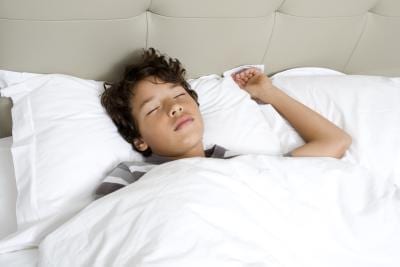Brief pauses in breathing during the wakeful hours are typically not problematic. These brief pauses are called apnea. When the apnea happens to someone asleep, it’s called sleep apnea, and it can cause disruptions in sleep patterns. Childhood sleep apnea can result from obstructions such as enlarged tonsils or adenoids. Parents and caregivers can benefit from knowing the signs and symptoms of childhood sleep apnea.
Breathing Symptoms During Sleep
Childhood sleep apnea can causes snoring, which can be loud, raspy or squeaky, followed by gasping or pauses in breathing. The gasps can awaken the child. A child’s breathing may be labored from sleep apnea. The child’s sleeping position may be unusual, and the night’s sleep can be restless. Stanford University points out that childhood sleep apnea can cause frequent episodes of obstructed breathing, and even though the child may not be aware of it, the parents may be extremely aware.
Other Nighttime Symptoms
Childhood sleep apnea may cause a child to sweat excessively during the night. For some children, severe bed-wetting is another symptom. Bad dreams or nightmares can result from childhood sleep apnea. The child’s mouth may be open during sleep. For younger children, there can be chest retraction, during which the chest pulls in.
Daytime Symptoms from Sleeping Pattern
Because sleep apnea can result in a sleep that is restless, the child can exhibit drowsiness during the day. An open mouth during sleep can result in a dry mouth. Headaches in the morning are signs of sleep apnea, and waking up can be associated with an ensuing headache.
Other Symptoms
Recurring restlessness resulting from childhood sleep apnea can contribute to other problems. A child may develop high blood pressure and be overweight or underweight. There could be problems with learning and with excessive irritability. Depression, changes in personality and difficulty with concentration are all signs that a child may suffer from sleep apnea. Other symptoms include developmental problems and a failure to grow and thrive. Behavior may become hyperactive. Childhood sleep apnea has also been associated with frequent upper respiratory infections.
Treatment of Symptoms
If the sleep apnea is a result of an obstruction such as an enlarged tonsil or adenoids, an adenotonsillectomy, which is the surgical removal of tonsils and adenoids, can be an effective treatment. Another treatment is called continuous positive airway pressure (CPAP), in which a child wears a nose mask during sleep.





